Cost Accounting Assignment: SBS BBA ACC, Semester 1
VerifiedAdded on 2022/08/23
|9
|1399
|32
Homework Assignment
AI Summary
This assignment solution covers fundamental concepts in cost accounting. It begins with an introduction to cost accounting, differentiating it from financial accounting, and outlining its advantages. The solution then addresses cost classification, cost drivers, and the application of cost sheets. It also includes calculations for contribution margin, breakeven points, and variance analysis. The assignment analyzes direct material and labor variances, providing a comprehensive overview of cost accounting principles and their practical application in business decision-making.
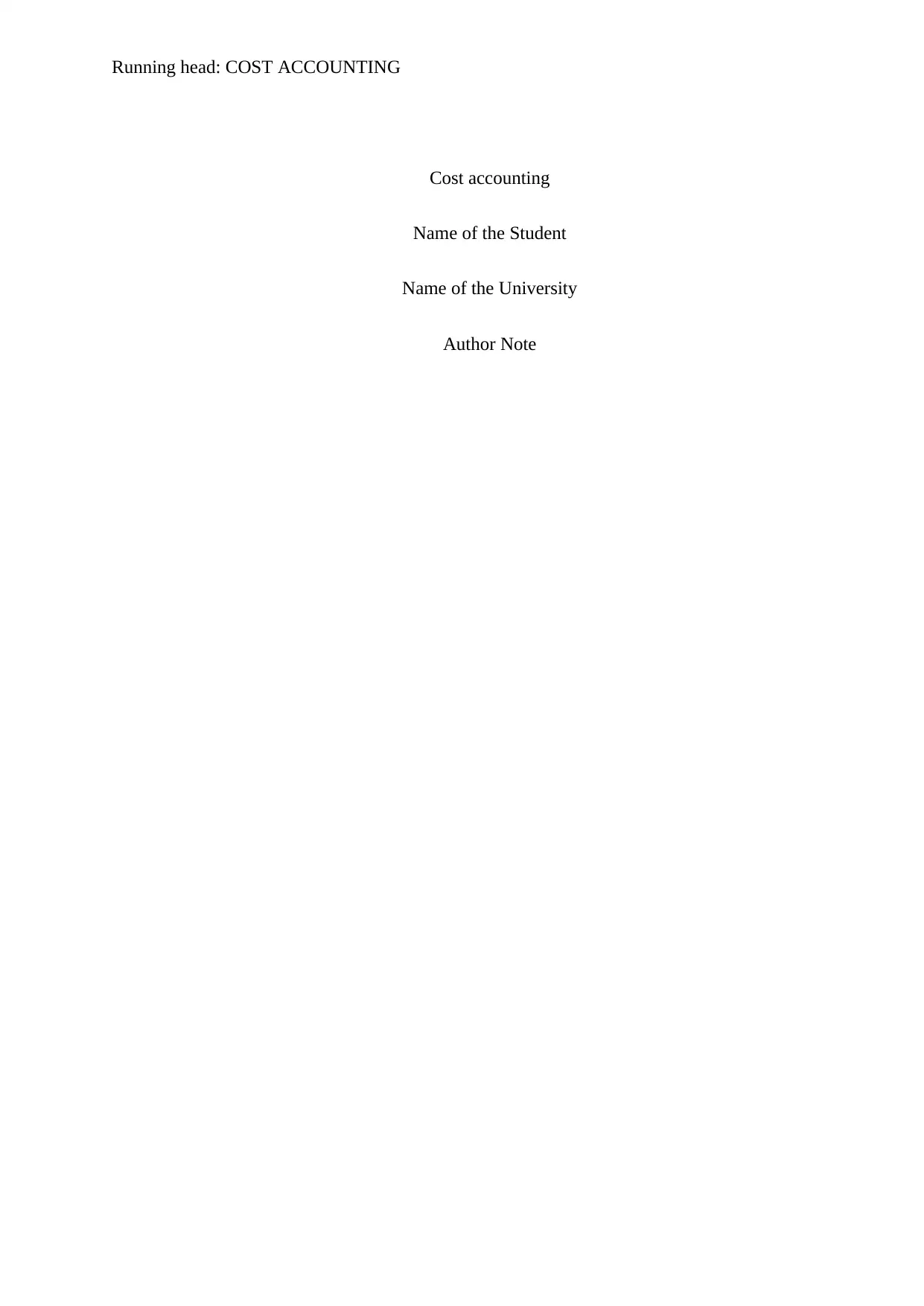
Running head: COST ACCOUNTING
Cost accounting
Name of the Student
Name of the University
Author Note
Cost accounting
Name of the Student
Name of the University
Author Note
Paraphrase This Document
Need a fresh take? Get an instant paraphrase of this document with our AI Paraphraser
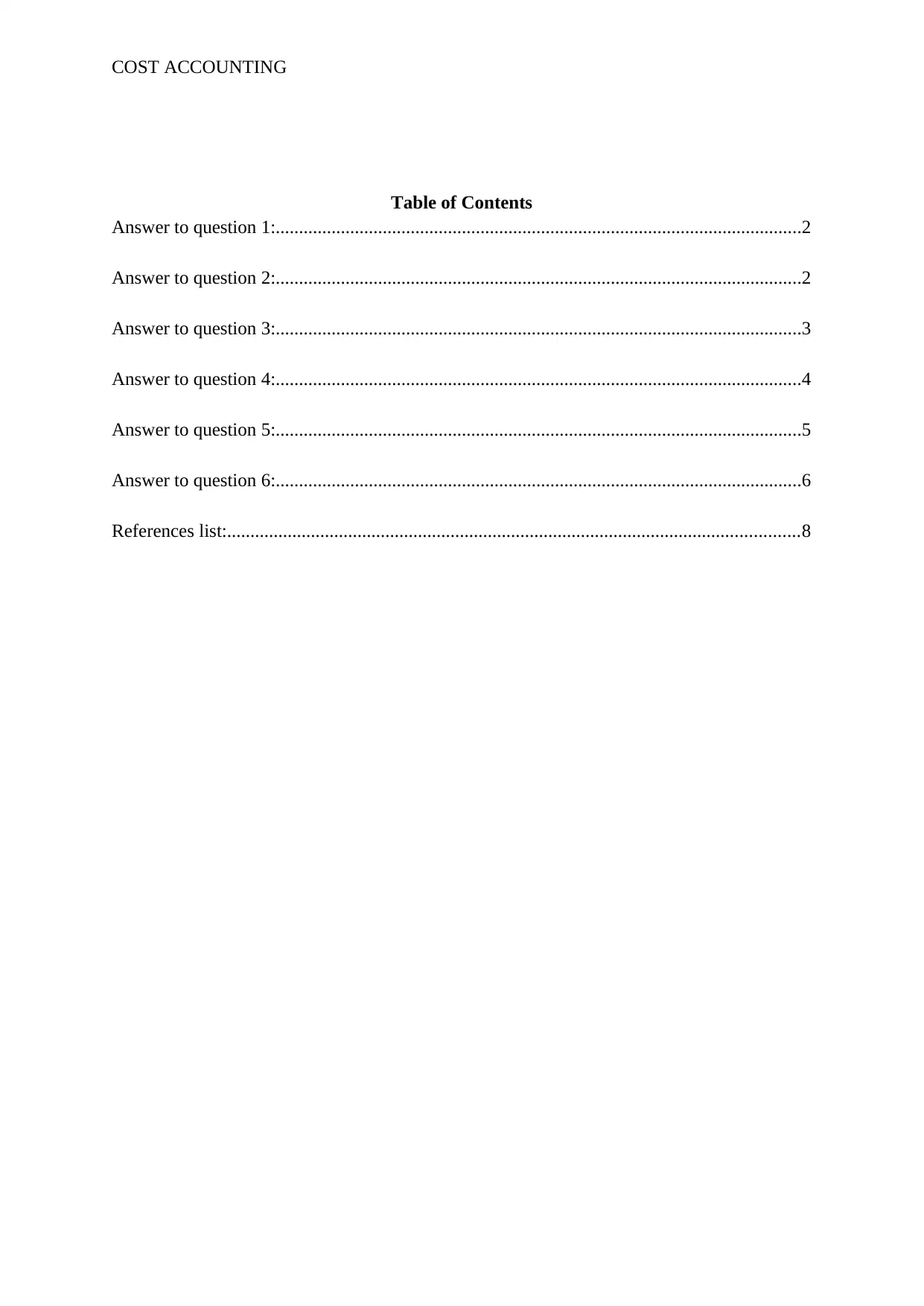
COST ACCOUNTING
Table of Contents
Answer to question 1:.................................................................................................................2
Answer to question 2:.................................................................................................................2
Answer to question 3:.................................................................................................................3
Answer to question 4:.................................................................................................................4
Answer to question 5:.................................................................................................................5
Answer to question 6:.................................................................................................................6
References list:...........................................................................................................................8
Table of Contents
Answer to question 1:.................................................................................................................2
Answer to question 2:.................................................................................................................2
Answer to question 3:.................................................................................................................3
Answer to question 4:.................................................................................................................4
Answer to question 5:.................................................................................................................5
Answer to question 6:.................................................................................................................6
References list:...........................................................................................................................8
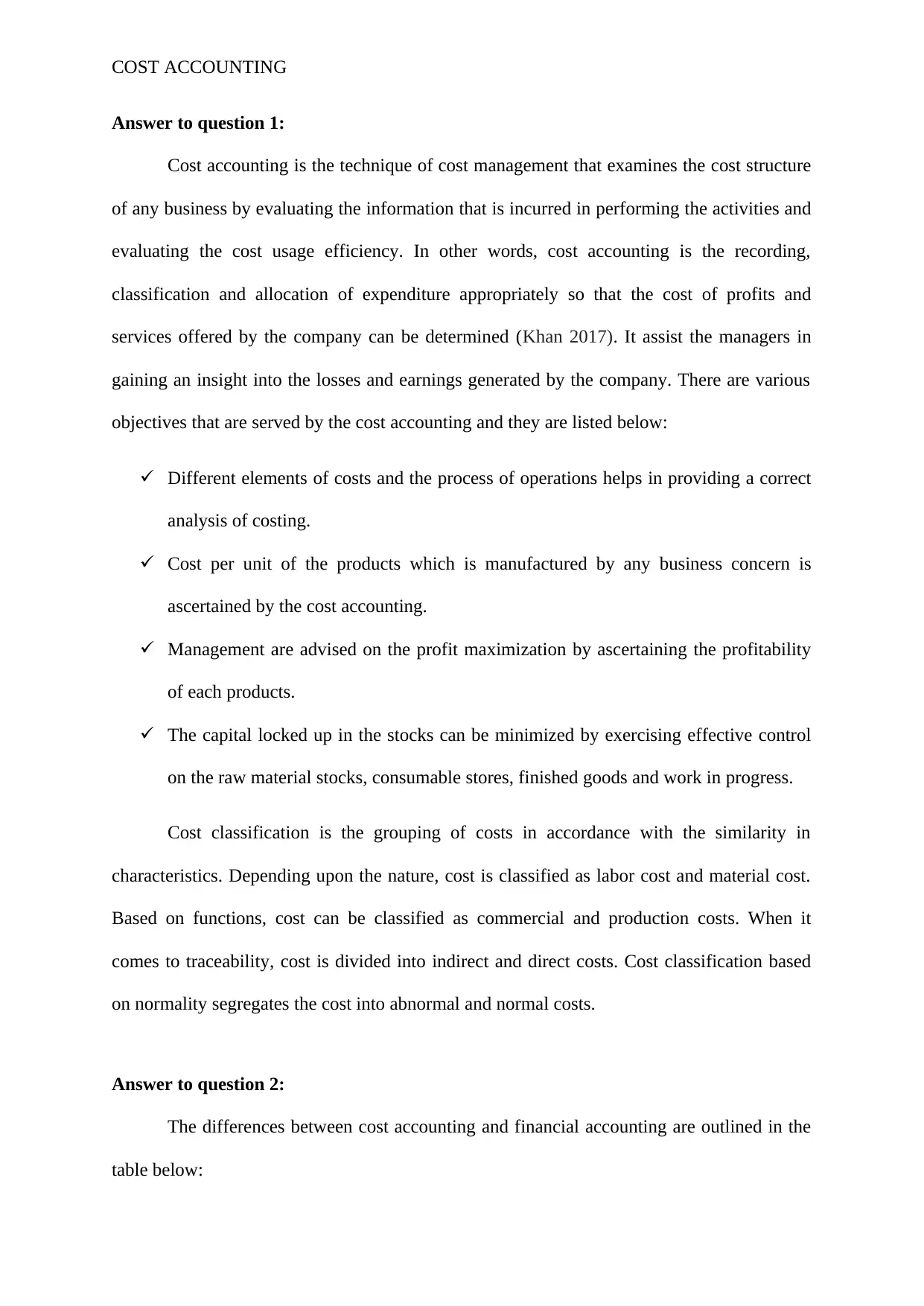
COST ACCOUNTING
Answer to question 1:
Cost accounting is the technique of cost management that examines the cost structure
of any business by evaluating the information that is incurred in performing the activities and
evaluating the cost usage efficiency. In other words, cost accounting is the recording,
classification and allocation of expenditure appropriately so that the cost of profits and
services offered by the company can be determined (Khan 2017). It assist the managers in
gaining an insight into the losses and earnings generated by the company. There are various
objectives that are served by the cost accounting and they are listed below:
Different elements of costs and the process of operations helps in providing a correct
analysis of costing.
Cost per unit of the products which is manufactured by any business concern is
ascertained by the cost accounting.
Management are advised on the profit maximization by ascertaining the profitability
of each products.
The capital locked up in the stocks can be minimized by exercising effective control
on the raw material stocks, consumable stores, finished goods and work in progress.
Cost classification is the grouping of costs in accordance with the similarity in
characteristics. Depending upon the nature, cost is classified as labor cost and material cost.
Based on functions, cost can be classified as commercial and production costs. When it
comes to traceability, cost is divided into indirect and direct costs. Cost classification based
on normality segregates the cost into abnormal and normal costs.
Answer to question 2:
The differences between cost accounting and financial accounting are outlined in the
table below:
Answer to question 1:
Cost accounting is the technique of cost management that examines the cost structure
of any business by evaluating the information that is incurred in performing the activities and
evaluating the cost usage efficiency. In other words, cost accounting is the recording,
classification and allocation of expenditure appropriately so that the cost of profits and
services offered by the company can be determined (Khan 2017). It assist the managers in
gaining an insight into the losses and earnings generated by the company. There are various
objectives that are served by the cost accounting and they are listed below:
Different elements of costs and the process of operations helps in providing a correct
analysis of costing.
Cost per unit of the products which is manufactured by any business concern is
ascertained by the cost accounting.
Management are advised on the profit maximization by ascertaining the profitability
of each products.
The capital locked up in the stocks can be minimized by exercising effective control
on the raw material stocks, consumable stores, finished goods and work in progress.
Cost classification is the grouping of costs in accordance with the similarity in
characteristics. Depending upon the nature, cost is classified as labor cost and material cost.
Based on functions, cost can be classified as commercial and production costs. When it
comes to traceability, cost is divided into indirect and direct costs. Cost classification based
on normality segregates the cost into abnormal and normal costs.
Answer to question 2:
The differences between cost accounting and financial accounting are outlined in the
table below:
⊘ This is a preview!⊘
Do you want full access?
Subscribe today to unlock all pages.

Trusted by 1+ million students worldwide
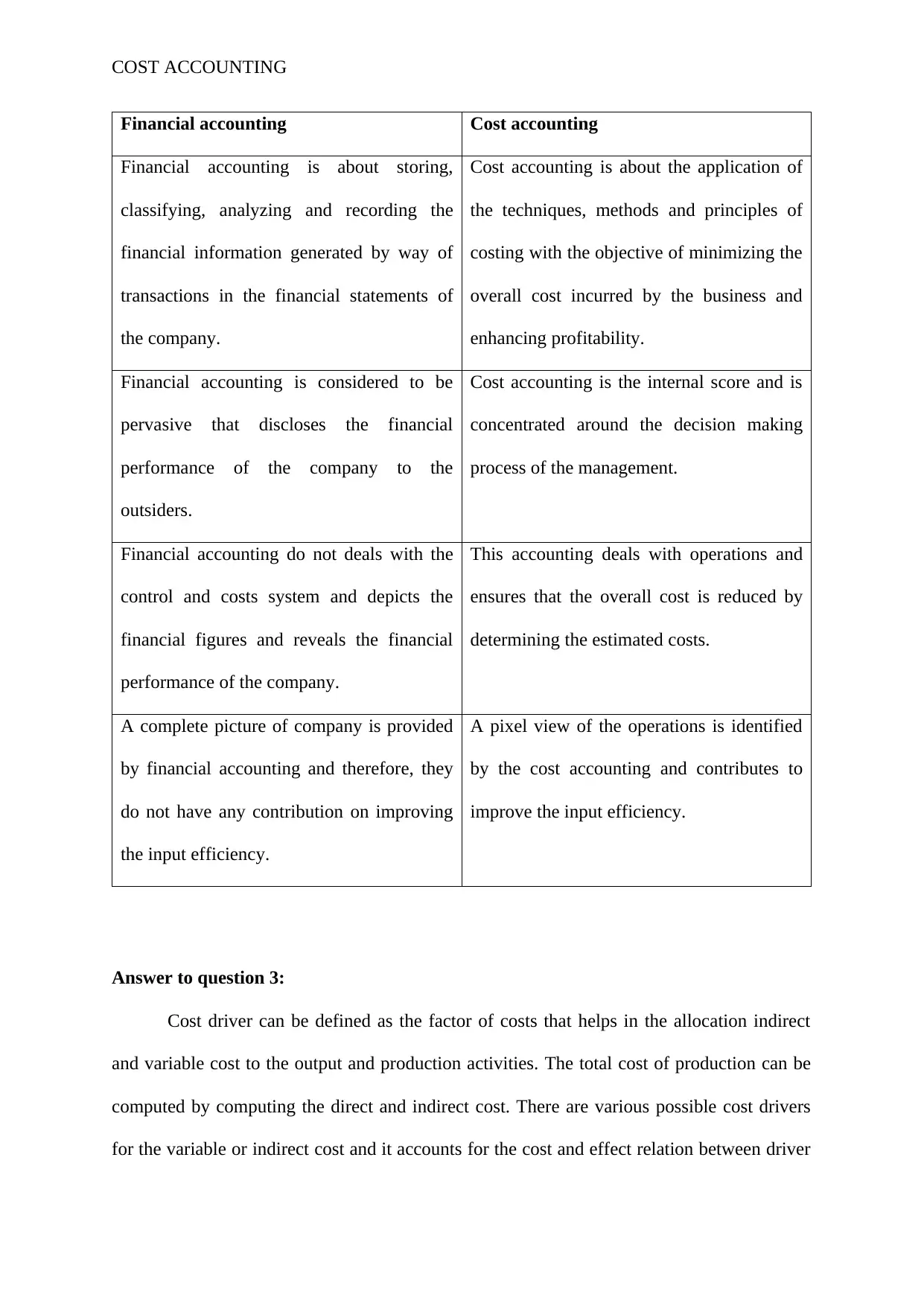
COST ACCOUNTING
Financial accounting Cost accounting
Financial accounting is about storing,
classifying, analyzing and recording the
financial information generated by way of
transactions in the financial statements of
the company.
Cost accounting is about the application of
the techniques, methods and principles of
costing with the objective of minimizing the
overall cost incurred by the business and
enhancing profitability.
Financial accounting is considered to be
pervasive that discloses the financial
performance of the company to the
outsiders.
Cost accounting is the internal score and is
concentrated around the decision making
process of the management.
Financial accounting do not deals with the
control and costs system and depicts the
financial figures and reveals the financial
performance of the company.
This accounting deals with operations and
ensures that the overall cost is reduced by
determining the estimated costs.
A complete picture of company is provided
by financial accounting and therefore, they
do not have any contribution on improving
the input efficiency.
A pixel view of the operations is identified
by the cost accounting and contributes to
improve the input efficiency.
Answer to question 3:
Cost driver can be defined as the factor of costs that helps in the allocation indirect
and variable cost to the output and production activities. The total cost of production can be
computed by computing the direct and indirect cost. There are various possible cost drivers
for the variable or indirect cost and it accounts for the cost and effect relation between driver
Financial accounting Cost accounting
Financial accounting is about storing,
classifying, analyzing and recording the
financial information generated by way of
transactions in the financial statements of
the company.
Cost accounting is about the application of
the techniques, methods and principles of
costing with the objective of minimizing the
overall cost incurred by the business and
enhancing profitability.
Financial accounting is considered to be
pervasive that discloses the financial
performance of the company to the
outsiders.
Cost accounting is the internal score and is
concentrated around the decision making
process of the management.
Financial accounting do not deals with the
control and costs system and depicts the
financial figures and reveals the financial
performance of the company.
This accounting deals with operations and
ensures that the overall cost is reduced by
determining the estimated costs.
A complete picture of company is provided
by financial accounting and therefore, they
do not have any contribution on improving
the input efficiency.
A pixel view of the operations is identified
by the cost accounting and contributes to
improve the input efficiency.
Answer to question 3:
Cost driver can be defined as the factor of costs that helps in the allocation indirect
and variable cost to the output and production activities. The total cost of production can be
computed by computing the direct and indirect cost. There are various possible cost drivers
for the variable or indirect cost and it accounts for the cost and effect relation between driver
Paraphrase This Document
Need a fresh take? Get an instant paraphrase of this document with our AI Paraphraser
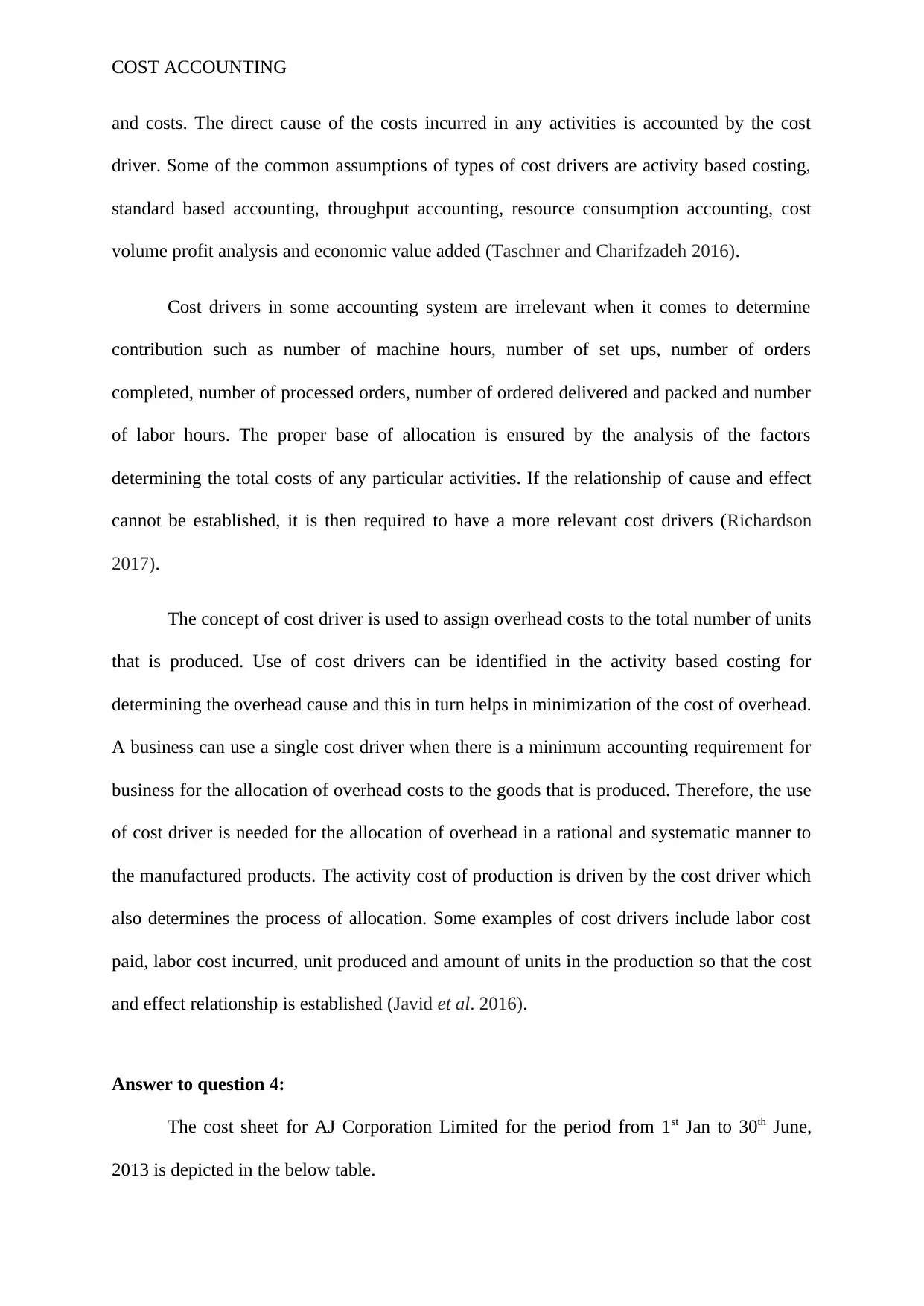
COST ACCOUNTING
and costs. The direct cause of the costs incurred in any activities is accounted by the cost
driver. Some of the common assumptions of types of cost drivers are activity based costing,
standard based accounting, throughput accounting, resource consumption accounting, cost
volume profit analysis and economic value added (Taschner and Charifzadeh 2016).
Cost drivers in some accounting system are irrelevant when it comes to determine
contribution such as number of machine hours, number of set ups, number of orders
completed, number of processed orders, number of ordered delivered and packed and number
of labor hours. The proper base of allocation is ensured by the analysis of the factors
determining the total costs of any particular activities. If the relationship of cause and effect
cannot be established, it is then required to have a more relevant cost drivers (Richardson
2017).
The concept of cost driver is used to assign overhead costs to the total number of units
that is produced. Use of cost drivers can be identified in the activity based costing for
determining the overhead cause and this in turn helps in minimization of the cost of overhead.
A business can use a single cost driver when there is a minimum accounting requirement for
business for the allocation of overhead costs to the goods that is produced. Therefore, the use
of cost driver is needed for the allocation of overhead in a rational and systematic manner to
the manufactured products. The activity cost of production is driven by the cost driver which
also determines the process of allocation. Some examples of cost drivers include labor cost
paid, labor cost incurred, unit produced and amount of units in the production so that the cost
and effect relationship is established (Javid et al. 2016).
Answer to question 4:
The cost sheet for AJ Corporation Limited for the period from 1st Jan to 30th June,
2013 is depicted in the below table.
and costs. The direct cause of the costs incurred in any activities is accounted by the cost
driver. Some of the common assumptions of types of cost drivers are activity based costing,
standard based accounting, throughput accounting, resource consumption accounting, cost
volume profit analysis and economic value added (Taschner and Charifzadeh 2016).
Cost drivers in some accounting system are irrelevant when it comes to determine
contribution such as number of machine hours, number of set ups, number of orders
completed, number of processed orders, number of ordered delivered and packed and number
of labor hours. The proper base of allocation is ensured by the analysis of the factors
determining the total costs of any particular activities. If the relationship of cause and effect
cannot be established, it is then required to have a more relevant cost drivers (Richardson
2017).
The concept of cost driver is used to assign overhead costs to the total number of units
that is produced. Use of cost drivers can be identified in the activity based costing for
determining the overhead cause and this in turn helps in minimization of the cost of overhead.
A business can use a single cost driver when there is a minimum accounting requirement for
business for the allocation of overhead costs to the goods that is produced. Therefore, the use
of cost driver is needed for the allocation of overhead in a rational and systematic manner to
the manufactured products. The activity cost of production is driven by the cost driver which
also determines the process of allocation. Some examples of cost drivers include labor cost
paid, labor cost incurred, unit produced and amount of units in the production so that the cost
and effect relationship is established (Javid et al. 2016).
Answer to question 4:
The cost sheet for AJ Corporation Limited for the period from 1st Jan to 30th June,
2013 is depicted in the below table.
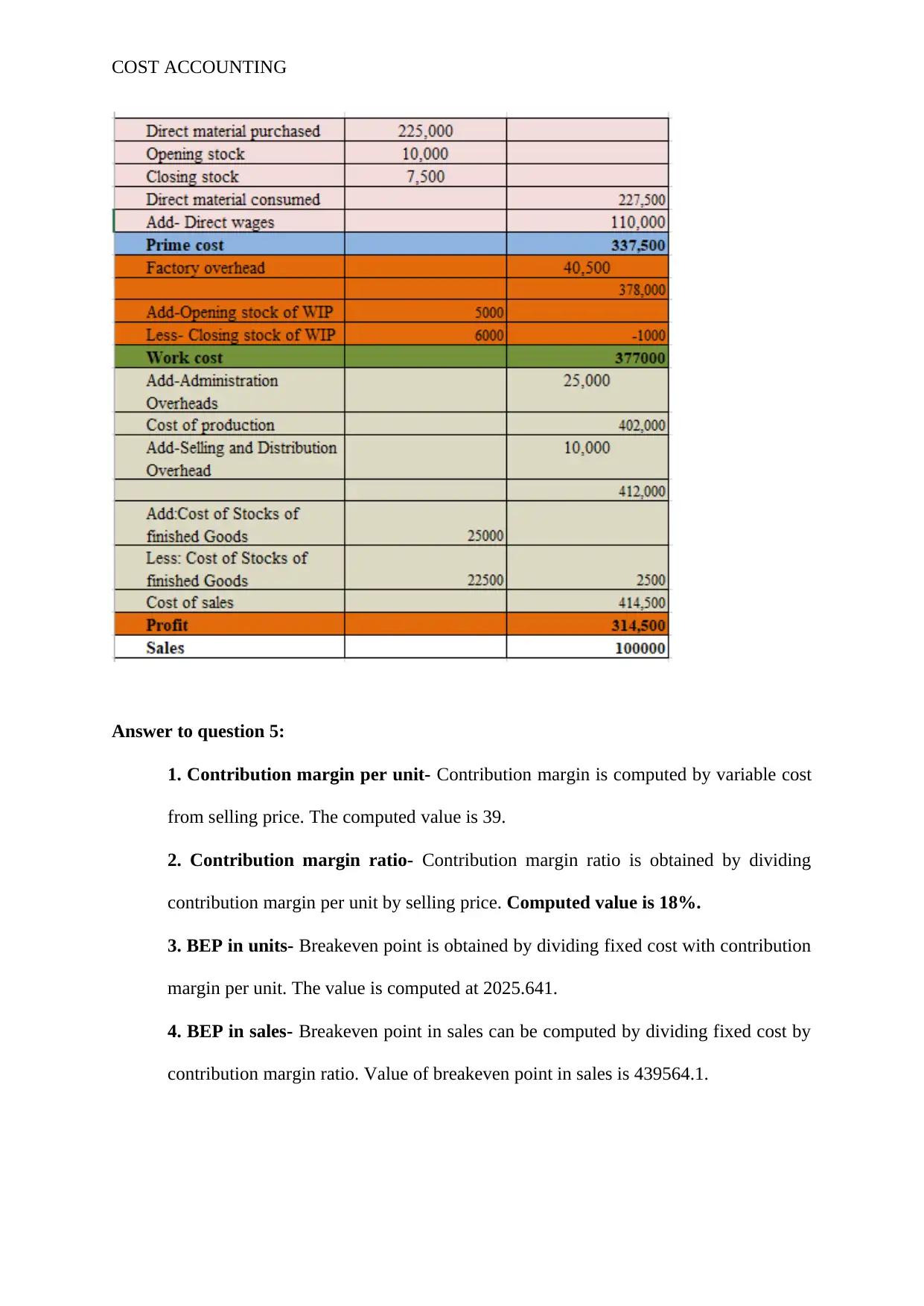
COST ACCOUNTING
Answer to question 5:
1. Contribution margin per unit- Contribution margin is computed by variable cost
from selling price. The computed value is 39.
2. Contribution margin ratio- Contribution margin ratio is obtained by dividing
contribution margin per unit by selling price. Computed value is 18%.
3. BEP in units- Breakeven point is obtained by dividing fixed cost with contribution
margin per unit. The value is computed at 2025.641.
4. BEP in sales- Breakeven point in sales can be computed by dividing fixed cost by
contribution margin ratio. Value of breakeven point in sales is 439564.1.
Answer to question 5:
1. Contribution margin per unit- Contribution margin is computed by variable cost
from selling price. The computed value is 39.
2. Contribution margin ratio- Contribution margin ratio is obtained by dividing
contribution margin per unit by selling price. Computed value is 18%.
3. BEP in units- Breakeven point is obtained by dividing fixed cost with contribution
margin per unit. The value is computed at 2025.641.
4. BEP in sales- Breakeven point in sales can be computed by dividing fixed cost by
contribution margin ratio. Value of breakeven point in sales is 439564.1.
⊘ This is a preview!⊘
Do you want full access?
Subscribe today to unlock all pages.

Trusted by 1+ million students worldwide
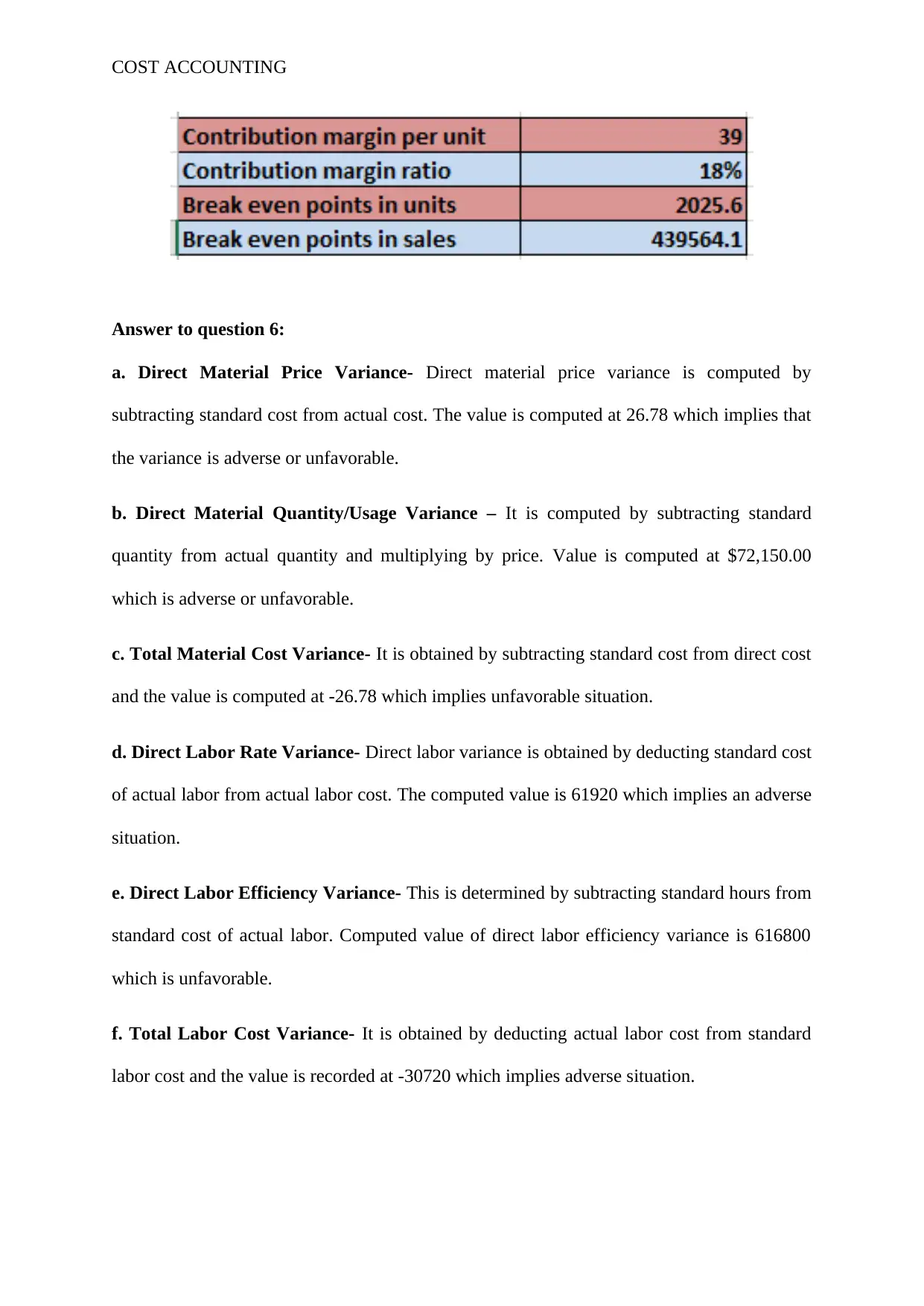
COST ACCOUNTING
Answer to question 6:
a. Direct Material Price Variance- Direct material price variance is computed by
subtracting standard cost from actual cost. The value is computed at 26.78 which implies that
the variance is adverse or unfavorable.
b. Direct Material Quantity/Usage Variance – It is computed by subtracting standard
quantity from actual quantity and multiplying by price. Value is computed at $72,150.00
which is adverse or unfavorable.
c. Total Material Cost Variance- It is obtained by subtracting standard cost from direct cost
and the value is computed at -26.78 which implies unfavorable situation.
d. Direct Labor Rate Variance- Direct labor variance is obtained by deducting standard cost
of actual labor from actual labor cost. The computed value is 61920 which implies an adverse
situation.
e. Direct Labor Efficiency Variance- This is determined by subtracting standard hours from
standard cost of actual labor. Computed value of direct labor efficiency variance is 616800
which is unfavorable.
f. Total Labor Cost Variance- It is obtained by deducting actual labor cost from standard
labor cost and the value is recorded at -30720 which implies adverse situation.
Answer to question 6:
a. Direct Material Price Variance- Direct material price variance is computed by
subtracting standard cost from actual cost. The value is computed at 26.78 which implies that
the variance is adverse or unfavorable.
b. Direct Material Quantity/Usage Variance – It is computed by subtracting standard
quantity from actual quantity and multiplying by price. Value is computed at $72,150.00
which is adverse or unfavorable.
c. Total Material Cost Variance- It is obtained by subtracting standard cost from direct cost
and the value is computed at -26.78 which implies unfavorable situation.
d. Direct Labor Rate Variance- Direct labor variance is obtained by deducting standard cost
of actual labor from actual labor cost. The computed value is 61920 which implies an adverse
situation.
e. Direct Labor Efficiency Variance- This is determined by subtracting standard hours from
standard cost of actual labor. Computed value of direct labor efficiency variance is 616800
which is unfavorable.
f. Total Labor Cost Variance- It is obtained by deducting actual labor cost from standard
labor cost and the value is recorded at -30720 which implies adverse situation.
Paraphrase This Document
Need a fresh take? Get an instant paraphrase of this document with our AI Paraphraser
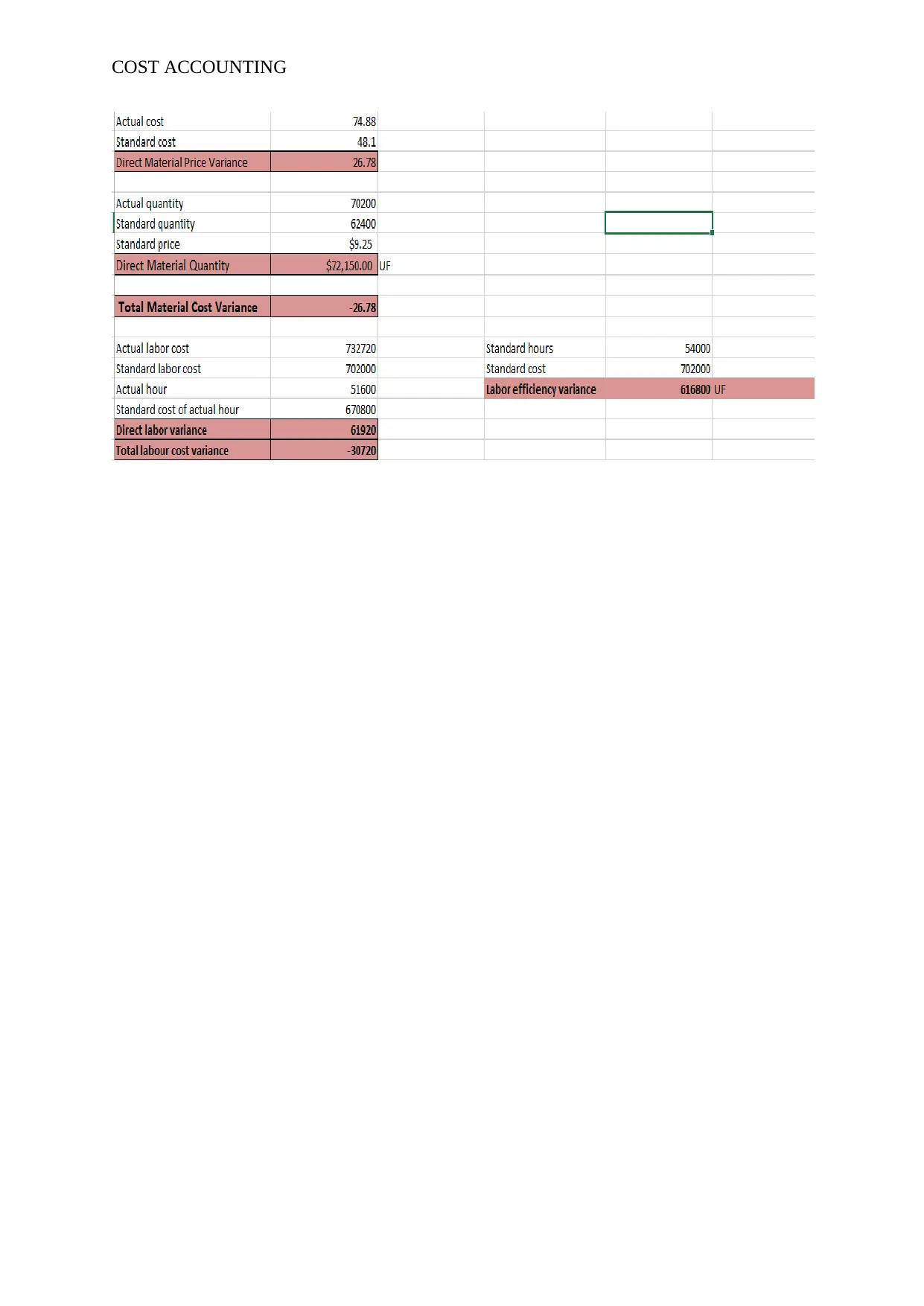
COST ACCOUNTING
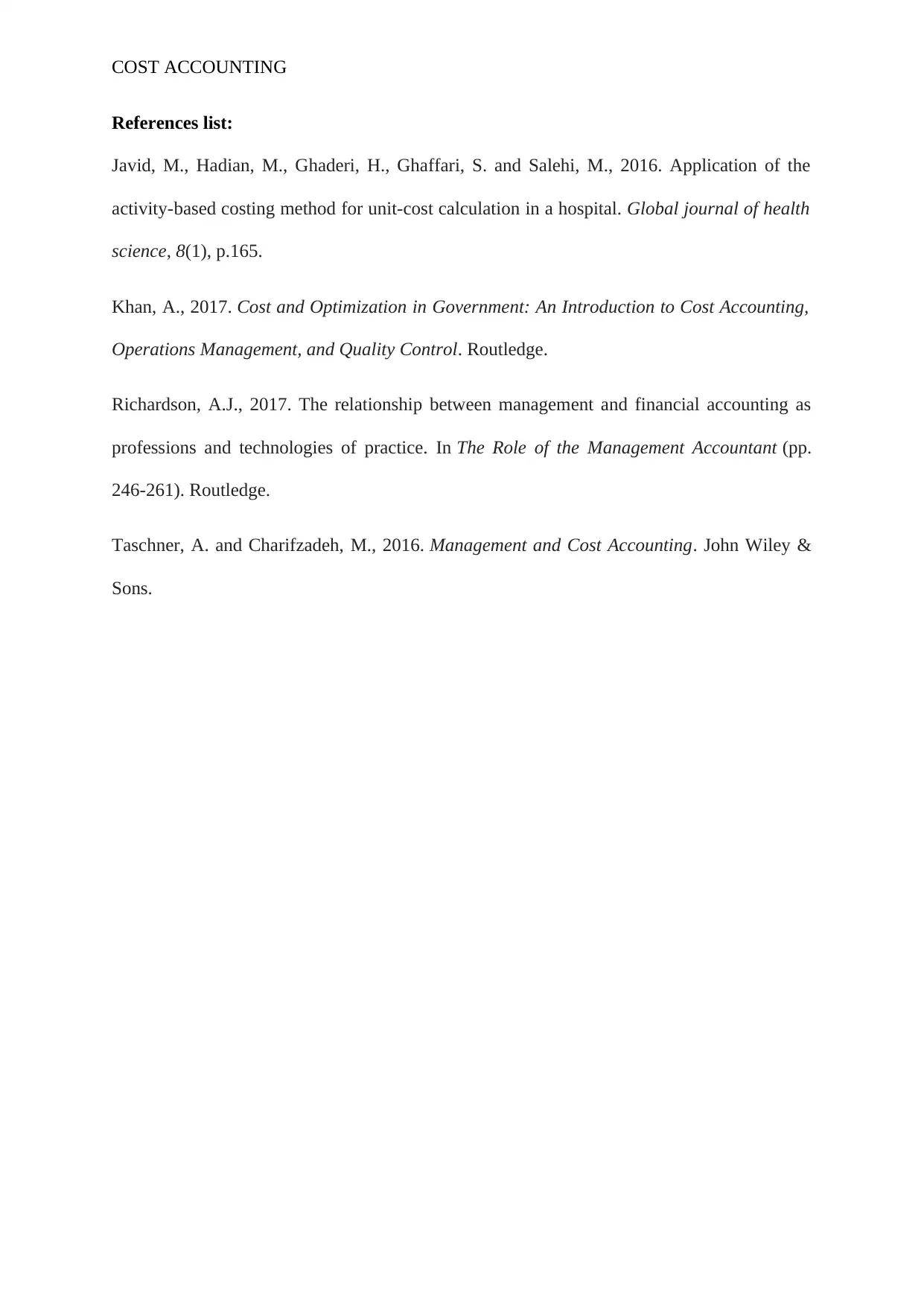
COST ACCOUNTING
References list:
Javid, M., Hadian, M., Ghaderi, H., Ghaffari, S. and Salehi, M., 2016. Application of the
activity-based costing method for unit-cost calculation in a hospital. Global journal of health
science, 8(1), p.165.
Khan, A., 2017. Cost and Optimization in Government: An Introduction to Cost Accounting,
Operations Management, and Quality Control. Routledge.
Richardson, A.J., 2017. The relationship between management and financial accounting as
professions and technologies of practice. In The Role of the Management Accountant (pp.
246-261). Routledge.
Taschner, A. and Charifzadeh, M., 2016. Management and Cost Accounting. John Wiley &
Sons.
References list:
Javid, M., Hadian, M., Ghaderi, H., Ghaffari, S. and Salehi, M., 2016. Application of the
activity-based costing method for unit-cost calculation in a hospital. Global journal of health
science, 8(1), p.165.
Khan, A., 2017. Cost and Optimization in Government: An Introduction to Cost Accounting,
Operations Management, and Quality Control. Routledge.
Richardson, A.J., 2017. The relationship between management and financial accounting as
professions and technologies of practice. In The Role of the Management Accountant (pp.
246-261). Routledge.
Taschner, A. and Charifzadeh, M., 2016. Management and Cost Accounting. John Wiley &
Sons.
⊘ This is a preview!⊘
Do you want full access?
Subscribe today to unlock all pages.

Trusted by 1+ million students worldwide
1 out of 9
Related Documents
Your All-in-One AI-Powered Toolkit for Academic Success.
+13062052269
info@desklib.com
Available 24*7 on WhatsApp / Email
![[object Object]](/_next/static/media/star-bottom.7253800d.svg)
Unlock your academic potential
Copyright © 2020–2025 A2Z Services. All Rights Reserved. Developed and managed by ZUCOL.




